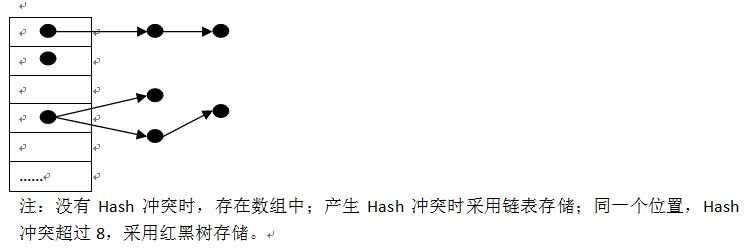标签:
背景
告警子系统监控4万个大网元所有端口的某些指标数据,根据阈值配置判断是否产生告警。采集——数据处理子系统每5分钟会主动采集24万次数据,发送24万条消息给告警子系统,这24万条消息涉及100万实体的数十个指标数据。告警子系统采用多节点部署方式分担压力,每个节点处理不同网元类型,不同实体,不同指标的数据。海量数据的过滤,必然会大量使用集合逻辑运算,使用不当,则会造成性能瓶颈。
例子
存在告警节点监控的实体动态变化,所以每个告警节点需要动态维护自己的监控列表,所以代码中会用到Collection.removeAll求差集的计算,计算出新增的实体,然后进一步计算出这些新增实体的历史平均值,方差等数据。
package com.coshaho.hash; import java.util.ArrayList; import java.util.List; public class HashObject { public static void main(String[] args) { List<String> list1 = new ArrayList<String>(); List<String> list2 = new ArrayList<String>(); // 2000长度的List求差集 for(int i = 0; i < 2000; i++) { list1.add("" + i); list2.add("" + (i + 1)); } long startTime = System.currentTimeMillis(); list1.removeAll(list2); long endTime = System.currentTimeMillis(); System.out.println("2000 list remove all cost: " + (endTime - startTime) + "ms."); // 10000长度的List求差集 list1.clear(); list2.clear(); for(int i = 0; i < 10000; i++) { list1.add("" + i); list2.add("" + (i + 1)); } startTime = System.currentTimeMillis(); list1.removeAll(list2); endTime = System.currentTimeMillis(); System.out.println("10000 list remove all cost: " + (endTime - startTime) + "ms."); // 50000长度的List求差集 list1.clear(); list2.clear(); for(int i = 0; i < 50000; i++) { list1.add("" + i); list2.add("" + (i + 1)); } startTime = System.currentTimeMillis(); list1.removeAll(list2); endTime = System.currentTimeMillis(); System.out.println("50000 list remove all cost: " + (endTime - startTime) + "ms."); } }
上述代码我们分别对长度为2000,10000,50000的List进行了求差集的运算,耗时如下:
2000 list remove all cost: 46ms. 10000 list remove all cost: 1296ms. 50000 list remove all cost: 31028ms.
可以看到,数据量每增加5倍,ArrayList的求差集运算时间消耗增加30倍。当我们进行数十万元素的求差集运算时,时间消耗是我们不可承受的。
Equals
实体过滤中,为了找到我们关心的实体数据,我们必然会采用Collection.contains过滤实体ID,这里面会使用到字符串equals方法判断两个ID是否相等。对于我们来说,两个字符串相等的含义就是两个字符串长度一致,对应位置的字符编码相等。如果大量字符串两两比较都采用上述算法,那将会进行海量的运算,消耗大量性能。这个时候,HashCode的作用就显得尤其重要。
HashCode
HashCode是int类型。两个对象如果相等(equals为true),则HashCode必然相等;反之,HashCode不等的两个对象,equals必然为false。最优秀的Hash算法,不相等的对象HashCode都不相同,所有equals比较都只调用HashCode的恒等比较,那么计算量就大大减小了。实际上,任何一个Hash算法都不能达到上述要求(HashCode为int类型,说明HashCode取值范围有限,对象超过int取值范围个数,就必然出现不相等对象对应同一个HashCode值)。不相等的对象对应相同的HashCode称之为Hash冲突。
但是,好的Hash算法确出现Hash冲突的概率极低。比如0.01%的Hash冲突概率,这样就意味着,我们平均进行10000次不相等对象的equals比较,只会出现一次Hash冲突,也就意味着只需要调用一次equals主逻辑。我们在设计equals方法时,先比较两个对象HashCode是否相等,不相等则返回false,相等才进行equals主逻辑比较。
原始的HashCode方法是由虚拟机本地实现的,可能采用的对象地址进行运算。String复写了HashCode方法,代码如下:
// Object public native int hashCode(); // String public int hashCode() { int h = hash; if (h == 0 && value.length > 0) { char val[] = value; for (int i = 0; i < value.length; i++) { h = 31 * h + val[i]; } hash = h; } return h; }
HashMap
HashMap是一个利用Key的HashCode进行散列存储的容器。它采用数组->链表->红黑树存储数据。结构如下图:

最简单的设想,计算一个Key在数组中的位置时,采用HashCode%数组长度求余计算则可(实际上JDK采用了更好的散列算法)。可以想象,相同的散列算法下,数组长度越长,Hash冲突概率越小,但是使用的空间越大。
JDK默认采用0.75为元素容量与数组长度的比例。默认初始化数组长度为16(采用2的n次方是考虑HashMap的扩容性能),当元素个数增加到16*0.75=12个时,数组长度会自动增加一倍,元素位置会被重新计算。在数据量巨大的情况下,我们初始化HashMap时应该考虑初始化足够的数组长度,特别是性能优先的情况下,我们还可以适当减小元素容量与数组长度的比例。HashMap部分源码:
/** * The default initial capacity - MUST be a power of two. */ static final int DEFAULT_INITIAL_CAPACITY = 1 << 4; // aka 16 /** * The maximum capacity, used if a higher value is implicitly specified * by either of the constructors with arguments. * MUST be a power of two <= 1<<30. */ static final int MAXIMUM_CAPACITY = 1 << 30; /** * The load factor used when none specified in constructor. */ static final float DEFAULT_LOAD_FACTOR = 0.75f; /** * Constructs an empty <tt>HashMap</tt> with the specified initial * capacity and load factor. * * @param initialCapacity the initial capacity * @param loadFactor the load factor * @throws IllegalArgumentException if the initial capacity is negative * or the load factor is nonpositive */ public HashMap(int initialCapacity, float loadFactor) { if (initialCapacity < 0) throw new IllegalArgumentException("Illegal initial capacity: " + initialCapacity); if (initialCapacity > MAXIMUM_CAPACITY) initialCapacity = MAXIMUM_CAPACITY; if (loadFactor <= 0 || Float.isNaN(loadFactor)) throw new IllegalArgumentException("Illegal load factor: " + loadFactor); this.loadFactor = loadFactor; threshold = initialCapacity; init(); } /** * Constructs an empty <tt>HashMap</tt> with the specified initial * capacity and the default load factor (0.75). * * @param initialCapacity the initial capacity. * @throws IllegalArgumentException if the initial capacity is negative. */ public HashMap(int initialCapacity) { this(initialCapacity, DEFAULT_LOAD_FACTOR); } /** * Constructs an empty <tt>HashMap</tt> with the default initial capacity * (16) and the default load factor (0.75). */ public HashMap() { this(DEFAULT_INITIAL_CAPACITY, DEFAULT_LOAD_FACTOR); }
大数据集合运算性能考虑
通过上述分析,我们知道在性能优先的场景下,大数据集合运算一定要使用Hash集合(HashMap,HashSet,HashTable)存储数据。文章开头的集合求余运算,我们修改为使用HashSet.removeAll,代码如下:
package com.coshaho.hash; import java.util.Collection; import java.util.HashSet; public class HashObject { public static void main(String[] args) { Collection<String> list1 = new HashSet<String>(); Collection<String> list2 = new HashSet<String>(); // 2000长度的List求差集 for(int i = 0; i < 2000; i++) { list1.add("" + i); list2.add("" + (i + 1)); } long startTime = System.currentTimeMillis(); list1.removeAll(list2); long endTime = System.currentTimeMillis(); System.out.println("2000 list remove all cost: " + (endTime - startTime) + "ms."); // 10000长度的List求差集 list1.clear(); list2.clear(); for(int i = 0; i < 10000; i++) { list1.add("" + i); list2.add("" + (i + 1)); } startTime = System.currentTimeMillis(); list1.removeAll(list2); endTime = System.currentTimeMillis(); System.out.println("10000 list remove all cost: " + (endTime - startTime) + "ms."); // 50000长度的List求差集 list1.clear(); list2.clear(); for(int i = 0; i < 50000; i++) { list1.add("" + i); list2.add("" + (i + 1)); } startTime = System.currentTimeMillis(); list1.removeAll(list2); endTime = System.currentTimeMillis(); System.out.println("50000 list remove all cost: " + (endTime - startTime) + "ms."); } }
运行效果如下:
2000 list remove all cost: 31ms. 10000 list remove all cost: 0ms. 50000 list remove all cost: 16ms.
标签:
原文地址:http://www.cnblogs.com/coshaho/p/5657333.html